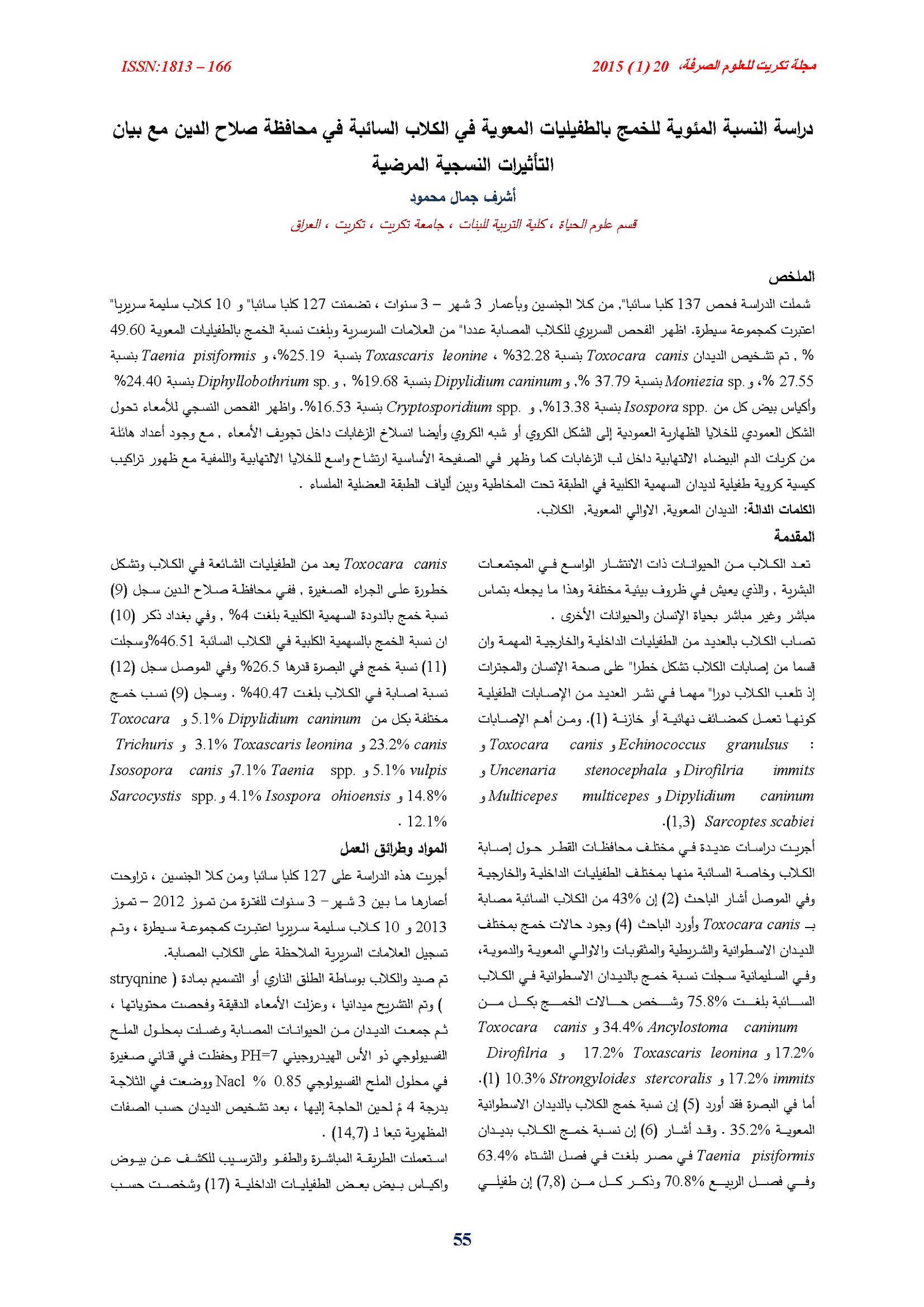Study the percentage of infection with intestinal parasites in dogs in salahaldin prevence
Main Article Content
Abstract
The study examined 137 stray dogs from both sexes and aged 3 months - 3 years old, included 127 stray dogs and 10 dogs clinically normal, served as a control group. Clinical signs were observed, the percentage of infection with intestinal parasites was 49.60%, was diagnosed with worms Toxocara canis 32.28%, Toxascaris leonine 25.19%, and Taenia pisiformis 27.55%, and Moniezia sp. 37.79%, and Dipylidium caninum 19.68%, and Diphyllobothrium sp. 24.40% and oocysts each of Isospora spp. 13.38%, and Cryptosporidium spp. 16.53%. histopathological examination of the intestines showed transformation the columnor epithelial cells to the spherical or semi-spherical shape and also alienation the villi in the intestinal cavity, with the infilteration of large numbers of inflammatory white blood cells inside the core of the villi also appeared in the lamina propria, agreat number of lymphocytes inflammatory cells with appearance of parasitic spherical cystic structures of worm Toxocara canis in the submucosal layer and between fibers of smooth muscle
Article Details

This work is licensed under a Creative Commons Attribution 4.0 International License.
Tikrit Journal of Pure Science is licensed under the Creative Commons Attribution 4.0 International License, which allows users to copy, create extracts, abstracts, and new works from the article, alter and revise the article, and make commercial use of the article (including reuse and/or resale of the article by commercial entities), provided the user gives appropriate credit (with a link to the formal publication through the relevant DOI), provides a link to the license, indicates if changes were made, and the licensor is not represented as endorsing the use made of the work. The authors hold the copyright for their published work on the Tikrit J. Pure Sci. website, while Tikrit J. Pure Sci. is responsible for appreciate citation of their work, which is released under CC-BY-4.0, enabling the unrestricted use, distribution, and reproduction of an article in any medium, provided that the original work is properly cited.
References
1-Saida, A.L. (2002). A survey of nematohelminthes in dogs of Sulaymania city. Kurdistan , Iraq. J. dohuk Univ.5: 19-22.
2-Abul-Eis, E.S.(1983). Studies on parasites of public health importance from dogs in Mosul. M.Sc. Thesis. Univ. of Mosul, Mosul, Iraq.
3-Urquhart,G.M.; Armour, J.; Duncan, J.L.; Dunn, A.M. & Jennings, f.w. (1999). Veterinary Parasitology. 2nd ed .Great Britian, Black well. 26-96.
4-Al-Khalidi,N.W.; Daoud, M.S.; Shubber, A.H. & Al-Alousi, T.I (1993). A survey for internal and external parasites in dogs in Mosul (Iraq). Iraqi J. Vet. Sci.1:9-15.
الع ا رقية للعلوم البيررية 2 : 55 - 606-Rasred,R.M.; Whitfield, P.J. & Lewis. J.W. (1991). The epidemiology of Taenia pisformis in infections in domestic in Cairo. J. Egypt Soc Parasitol;21:597-610.
7-Soulsby, E.J.L. (1982). Helminths Arthopods and Protozoa of domesticated animals. 7th ed. London, Bailliere, Tindall. 155-464.
8-Glickman, L.T.; Dubey, J.P. & Winslow, L.J. (1981). Serological response of ascarid free dogs to Toxocara canis infection. Parasitol. J.82: 383-387.
11- Al- Azizz , S . A . A . (2005) . Epidemiological and sero – immunological studies of Toxocara canis (Werner, 1782 ) and record of some species of intestinal parasites from stray dogs in Basrah governorate . Ph. D. Thesis Coll. Educ. Univ. Basrah :16 z pp.
13-Borkoveova,M. (1999).Endoparasites of some species of domistical animas in Tisnovsko district. Thesis. Mendel Univ. of Agriculture and Forestry Brno. 143pp.
14- Yamaguti , S . (1961) . Systema Helminthum . Ist ed ., chancery lane , London : 679 pp .
15-Kassai, T. (1999). Veterinary Helminthology. Great Britain; Bath press, 184-203.
16-Forety, W.J. (2001). Veterinary Parasitology, Reference manual. 5th ed. Lowa State, Blackwell Publishing Co. 17-45.
17- Banchroft, J. D .& Stevens, A . (1982) . Theory and practice of Histological Techniques. zed. Churchill Livingstone, Inc ., New York, pp : 662 .
18- Humason, G.L. (1967). Animal tissue techniques. Zed. W. H. Freemon comp. Sanfrancesco. pp : 427.
19-Petrie,A. & Watson, P. (1999). Statistics for veterinary and animal science. Black well . 79-113.
20-Dumanli,N.(1984). Paevalence of protozoa in dogs in the Elazing area. Turkey Vet. Fak Firat Univ., 31: 383-387.
21-El-Ahra f, A.J.V.; Tacal, M.; Sobih, M. ; Amin, W.; Lawrence, W. & Wilcke, B.W. (1991). Prevalence of Creptosporidiosis in dogs and human beings in san Bernardino, California, J. Am Vet. Med. Assoc., 198: 631- 634.
22-Grimason, M.H.V.; F.W.; Parker, M.H.; Jackson, P.G.; Smith, P.G. & Girdwood, R.W.A. (1993). Occurrence of Giardia spp. Cysts and Cryptosporidium spp. Oocysts in faeces from public parks in the west of Scotland . Epidemiol Infect . 110: 641-645.
23-Johnston, J. & Gasser, R.B.(1993). Copro Parasitological survey of dogs in southern Victoria . Aust. Vet. Pract. 23:127-131.
24- Mustafa, F. A. (1999). Pathological effects of Paradilepis delachauxi (Fuhrman, 1909) (Cestode: Dilepidae) in alimantry canal of the Phalacrocorax pygmaeus in Basrah, Iraq. J. Basrah Researches, 20 (part 1) : 23-26.
